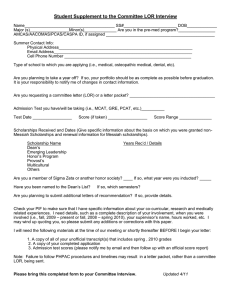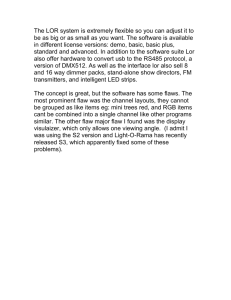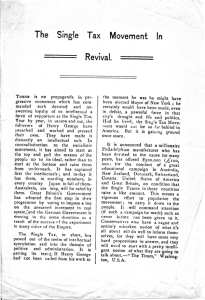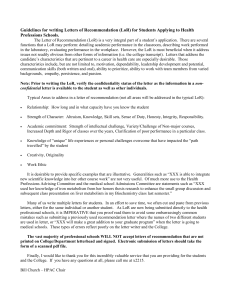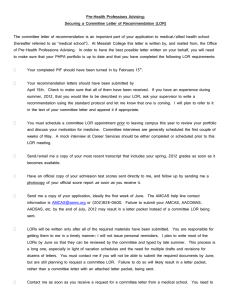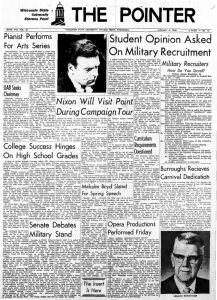LOR - GE Grid Solutions
advertisement
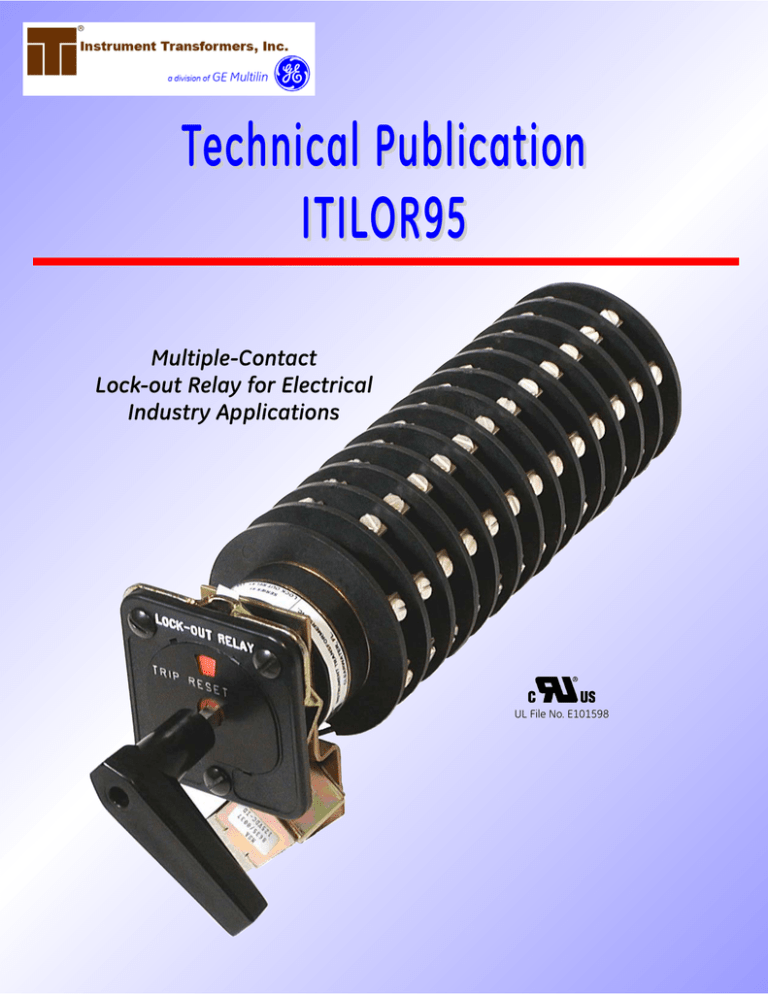
Technical Publication ITILOR95 Multiple-Contact Lock-out Relay for Electrical Industry Applications UL File No. E101598 LOCK-OUT RELAY SWITCH INTRODUCTION The Lock-Out Relay (LOR) with up to 20 sets of N.O. & 20 set of N.C. contacts is used in the electrical power industry. These control relays are often used in conjunction with differential relays for the protection of transformers, buses, and rotating machinery. During a predetermined condition a LOR that has been RESET is electrically tripped to the TRIP position indefinitely. As a result, the LOR automatically locks out other circuit breakers and devices and must be RESET after the condition is eliminated. OPERATION The LOR requires no special circuity expect for a N.O. contact (S1) to trip the relay. The selection of the N.O. contact S1 should take into consideration the burden of trip coil and only external targets, since it will close into this current. Since the LOR is self—interrupting the S1 contact need not be concerned with breaking the TRIP circuit. MANUAL RESET LOR CIRCUIT The LOR contacts is shown in Figure 1 are normally closed in the reset position. B and G are the tie points that connect the LOR to the control circuit. C and F ate the connection points for the integral trip coil. The state of the N.O. contact S1 determines whether the LOR is in the TRIP or RESET position. When the LOR is in the RESET position, the N.O. contact of S1 closes to energize the LOR’s trip coil. This causes the LOR to open it ’s N.C. contacts, lock into the TRIP position, and remove itself from the circuit. An orange or black mechanical flag indicates TRIP position Black indicates RESET position. + S1 LOR LOR T LOR FIGURE 1 MANUAL RESET LOR CONTROL CIRCUIT IN RESET POSITION 1 www.GEMultilin.com OPERATING VOLTAGE & COIL DATA BURDEN The LOR is self-interrupting auxiliary relay which is energized for short periods of time. Based on 105oC class insulation this relay can be subjected to it’s maximum design voltage without exceeding a 50oC rise in a 55oC ambient. As shown in Fig 2 the LOR operates reliably over a wide range of voltages. Solenoids A, B, C, D, E, and F have overlapping voltages ranges to provide flexibility when selecting an operating speed for a specific burden current G and H coils may be useful where the sum of stray voltages cause nuisance trips. For normal operation the voltage applied at the control bus should be within the operating range outline in Figure 2. COIL COIL CKT VOLTAGE COIL RESISTANCE o @ 25 C OPERATING RANGE COIL CURRENT @ NORMAL VOLTAGE COIL CURRENT @ MAXIMUM VOLTAGE VOLTAGE A 24VDC 3.3 10—40VDC 7.3 12.2 AMPS DC B 24VDC 7.7 18—50VDC 3.2 6.5 AMPS DC C 48VDC 1.3 24—70VDC 3.7 5.4 AMPS DC D 125VDC 27 30—140VDC 4.6 5.2 AMPS DC E 125VDC 50 45—150VDC 2.5 2.8 AMPS DC F 250VDC 104 70—280VDC 2.4 2.7 AMPS DC G 125VDC 27 90—140VDC 2.5 2.8 AMPS DC H 250VDC 104 180—280VDC 2.4 2.7 AMPS DC FIGURE 2 The operating range represents the design limits for reliable operation. Safety margins are included so operation may occur well outside this range. There is no implied threshold voltage in the operating range. In fact, actuation may occur at less than half of the lower limit of the operating range - contact factory if threshold voltage levels are required. Recommended control circuitry is shown in Figures 1-8 using a normally open contact to initiate operation. Applying continuous voltages that do not actuate the relay may cause overheating and failure of the coil. LOR TARGETS All LOR’s have a mechanical target incorporated into nameplate. It’s position and color indicate the state of the relay, black for RESET and orange for TRIP. The target resets when the relay resets. Auxiliary targets may be used in combination with LOR to remotely indicate the status of the relay. When wired in series as in Figure 2, the .2A target operates suitably with LOR. However, because of the relay’s fast time response the 2A targets need special attention. Refer to figures 4 thru 8 toselect the appropriate coil to target match, and circuit configurations for 2A targets. S1 Target relay coil LOR interrupter contacts LOR trip LOR interrupter contacts FIGURE 3 SERIES LOR COIL W/TARGET www.GEMultilin.com 2 Tests based on following Target coil Characteristics TARGET .2A .6A 2A Coil resistance (ohms) 8.15 .71 .195 Pull— in current (amps) .15 .45 1.75 LOR TRIP COILS TO USE .2 A TARGET 2 A TARGET OPERATING DC VOLTS 150 125 A, B, C B,C,D,E 150 125 140 D,E,F D,E,F D,E,F D D 190 250 F F D D FIGURE 4 LOR TRIP COIL LOR COIL SELECTION NO ADDITIONAL CIRCUITY (TARGET) 2A TARGET RESISTOR (Rp) IN PARALLEL .2A .6A 25 OHMS A B 12 12 42 C D 24 40 118 E F 40 150 G 90 H 180 2A 50 OHMS 2A TARGET RC CIRCUIT C1 40 MFD 20 MFD 2A TARGET SERIES RESISTOR (RS) 7 OHMS 12.3 OHMS 16.7 OHMS 90 90 95 80 75 70 95 105 150 125 FIGURE 5 MINIMUM D.C. VOLTAGE FOR OPERATION OF TARGET + S1 Target relay coil LOR interrupter contacts LOR RP LOR interrupter contacts - FIGURE 6 3 LOR TRIP CIRCUIT WITH PARALLEL RESISTER (Rp) SEE FIG 5 FOR RECOMMENDED VALUES OF Rp. www.GEMultilin.com + S1 Target relay coil Special LOR contact R2—5 OHMS R1 22K C1 - FIGURE 7 LOR TRIP CIRCUIT BRIEFLY CONNECTED WITH RC NETWORK INCREASES CURRENT THROUGH 2A TARGET. SEE FIGURE 5 FOR RECOMMENDED CAPACITOR VALUES. + S1 Target relay coil Rs LOR interrupter contact LOR trip coil LOR interrupter contact - FIGURE 8 SERIES RESISTOR (Rs) IN LOR TRIP CIRCUIT REDUCE COIL WATTAGE. SEE FIGURE 5 FOR CORRECT RESISTOR VALUES. CONTACT MATERIALS: The LOR operates to a knife switch with double sided, spring wiper blades that close on a stationary terminal A.N.C. contact is achieved by bridging two stationary terminals. Made of phosphor—bronze, the wiper blades take advantage of the fine electrical conductivity and spring quality it provides. The blades are formed and riveted together to provide uniform pressure betweenthe mating surfaces. The stationary terminal are made of a copper material. All contact surfaces are overlayed with silver. A final overall silver flashing of the terminals insures good contact for external connections. DECKS ARRANGEMENT: A maximum number of 10 decks are available on the LOR for a total of twenty sets of NO and twenty sets of NC contacts. Using a blade and terminal configuration allows each deck to provide two N.O. and two N.C. contacts. Multi—deck LOR’s have a two digit number associated with each terminals. The first digit refers to the deck number and the second indicates angular position . Consequently, terminal 68 would be located on the sixth deck in eighth position. www.GEMultilin.com 4 CONTACT DECK LAYOUT n=deck number FIGURE 10 CONTACT CHART & DECK LAYOUT CONTACT RATINGS: The LOR uses were tested per U.L.Standard 508 and are documented in U.L. File Number E101598. See Figure 11 for actual general purpose U.L. recognized ratings. U.L RECOGNIZED CONTACT RATING 120Vac 240Vac 600Vac 125Vac 250Vac 20A 15A 6A 3A 1A FIGURE 11 CONTACT CHART TRIP AND REST MECHANISM: THE LOR uses a small linear solenoid with a mechanical advantage to control the heavy spring action required for tripping. A lever mechanism locks the LOR into the RESET position. Once RESET the full force of the main spring is transmitted perpendicular to a rolling surface. This locks the relay into the RESET position so that neither the lever nor a small roller can move. When energized the solenoid pushes against the lever, the small roller moves, and the LOR trips. Resetting the LOR requires the handle to be rotated clockwise until the roller a lines again with lever. 5 www.GEMultilin.com www.GEMultilin.com Technical Publication ITILOR95 USA, Canada, Asia, Latin America Tel: +1-800-547-8629 Fax: +1-905-201-2455 e-mail: sales.multilin@ge.com Series 95 Lock Out Relay Europe, Middle East, Africa Tel: +34-94-485-88-00 Fax: +34-94-485-88-45 e-mail: gemultilin.euro@ge.com Please refer to our website www.GEMultilin.com for more detailed contact information CS00A40787 Rev.7 2/10

